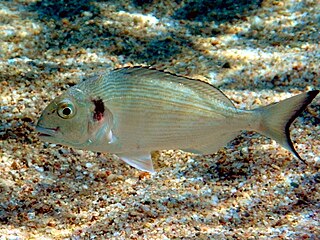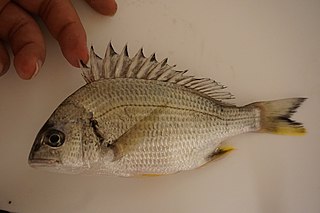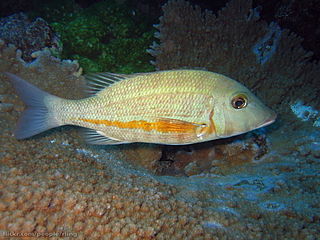
Sparidae is a family of ray-finned fishes belonging to the order Spariformes, the seabreams and porgies, although they were traditionally classified in the order Perciformes. They are found in shallow temperate and tropical waters around the world and are demersal carnivores.

Acanthopagrus schlegelii, the blackhead seabream, black porgy or black seabream, is a species of marine ray-finned fish belonging to the family Sparidae, the seabreams and porgies. This species is found in the Western Pacific Ocean. The blackhead seabream is an important species in commercial fisheries, particularly in Vietnam.

The gilt-head bream, also known as the gilthead, gilt-head seabream or silver seabream, is a species of marine ray-finned fish belonging to the family Sparidae, the seabreams or porgies. This fish is found in the Eastern Atlantic and the Mediterranean. It is a highly esteemed food fish and an important species in aquaculture.

Acanthopagrus latus, the yellowfin seabream, grey bream, Houttuyn's yellowfin seabream, Japanese bream or yellow-finned black porgy, is a species of marine ray-finned fish belonging to the family Sparidae, the seabreams and porgies. This fish is found in the Western Pacific Ocean.

Argyrops spinifer, the king soldierbream, Bowen snapper, long-spined red bream, longfin snapper, longspine seabream and red bokako, It is a species of marine ray-finned fish belonging to the family Sparidae. This species is found in the Indian Ocean.

Rhabdosargus sarba, also known as the goldlined seabream, silver bream, tarwhine, or yellowfin bream, is a species of marine ray-finned fish belonging to the family Sparidae, which includes the seabreams and porgies. This fish has a wide Indo-Pacific distribution.

Lethrinus obsoletus, the orange-striped emperor, yellow-banded emperor or yellowstripe emperor, is a species of marine ray-finned fish belonging to the family Lethrinidae, the emperors or emperor breams. This species has a wide Indo-Pacific distribution.

Lethrinus harak, the thumbprint emperorblackblotch emperor or blackspot emperor, is a species of marine ray-finned fish belonging to the Family Lethrinidae. the emperors and emperor breams. This species is found in the Indo-Pacific region.

Sparidentex is a genus of ray-finned fish belonging to the family Sparidae, which includes the seabreams and porgies. These fishes are found in the Indian Ocean.

Acanthopagrus is a genus of marine ray-finned fishes belonging to the family Sparidae, the sea breams and porgies. The fish in this genus are found in the Indian and western Pacific Oceans.

Rhabdosargus is a genus of ray-finned fish belonging to the family Sparidae, which includes the seabreams and porgies. These fishes are found in the southeastern Atlantic Ocean and throughout the Indo-West Pacific, although mainly in the western Indian Ocean.
Silver bream is the common name of several species of fish:

Crenidens is a small genus of three species of seabream from the family Sparidae from the western Indian Ocean. It was previously regarded as monotypic, with the sole species being the Karenteen sea bream Crenidens crenidens but two other species are now accepted as valid species, separate from the type species, C. crenidens.
Yellowfin bream, yellow bream, yellow sea bream, or yellowfin sea bream are the common names for several species of sea breams with very similar appearances:
Acanthopagrus taiwanensis, the Taiwan picnic seabream, is a species of marine ray-finned fish belonging to the family Sparidae, the sea breams and porgies. This species is found in the northwestern Pacific Ocean in the waters around Taiwan.
Acanthopagrus morrisoni, the western yellowfin seabream, yellow sea bream or datina, is a species of marine ray-finned fish belonging to the family Sparidae, the seabreams and porgies. This fish was previoulst regarded as conspecific with A. latus but has now been recognised as a separate valid species restricted to the northwestern coasts of Australia.

Argyrops is a genus of marine ray-finned fishes belonging to the family Sparidae, the seabreams and porgies. These fishes are found in the coasts of Indian Ocean and near Australia.

Crenidens indicus. Day's karanteen bream, is a species of marine ray-finned fish belonging to the family Sparidae, which includes the seabreams and porgies. This species is found in the Indian Ocean.

Rhabdosargus haffara, the haffara seabream or Haffara stumpnose, is a species of marine ray-finned fish belonging to the family Sparidae, which includes the seabreams and porgies. This fish is found in the northwestern Indian Ocean.

Acanthopagrus bifasciatus, the twobar seabream, is a species of marine ray-finned fish belonging to the family Sparidae, the sea breams and porgies. This species is found in the northwestern Indian Ocean.















